Round The World and other travels
A frequent flyer's collection of trip diaries
This is: Round The World 2015
Charming and cultured: getting to know Luang Prabang
The day began as usual with breakfast in the hotel. It was a bit of a comedown after our first-meal-of-the-day experiences at the InterContinental Phnom Penh and Raffles Siem Reap, but at least my fried-to-order eggs were nice. We were filled with anticipation: it looked like being a glorious day weather-wise, and Bruce's research had indicated that Luang Prabang might actually turn out to be the highlight of our entire round-the-world journey, even after experiencing Angkor. Nestled amid verdant mountains along the banks of the Mekong, the city held out the promise of stunning colonial heritage reflected in its architecture and cuisine - a place where Buddhist monks appeared to be perfectly at home among stylish hotels and restaurants. WikiTravel had said that it was "perhaps the most charming city in all of Southeast Asia".
Here's a short introduction to the city and the country, courtesy of Bruce:
| LAOS and Luang Prabang | ||
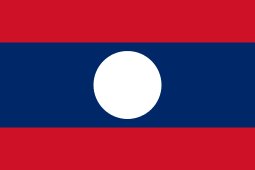 Luang
Prabang, the former royal capital of Laos, was established
in 1353 as Lan Xang Hom Khao. The original name
means 'Kingdom of a Million Elephants and the White Parasol'
in Khmer, and it reflected the city's military and royal
status. Shortly thereafter, one of the prince’s benefactors
sent him a sacred Prabang, a golden Buddha image
from Sri Lanka, and it was from
this that the city took its current name. The administrative
capital of Laos was moved to Vientiane in 1545, but Lao
royalty continued to reside in Luang
Prabang until the Communist takeover in 1975. Luang
Prabang, the former royal capital of Laos, was established
in 1353 as Lan Xang Hom Khao. The original name
means 'Kingdom of a Million Elephants and the White Parasol'
in Khmer, and it reflected the city's military and royal
status. Shortly thereafter, one of the prince’s benefactors
sent him a sacred Prabang, a golden Buddha image
from Sri Lanka, and it was from
this that the city took its current name. The administrative
capital of Laos was moved to Vientiane in 1545, but Lao
royalty continued to reside in Luang
Prabang until the Communist takeover in 1975.As with Cambodia next door, but minus the genocide, the Communist era saw the mass departure of businessmen, academics, scholars and royalty, and progress basically ground to a standstill until the fall of the Soviet Union in the 1990s. Laos was never heavily populated to begin with, and the population is now back to pre-1975 levels, although that means around 7 million people in a country nearly twice the size of England. Luang Prabang was designated a UNESCO World Heritage Site in 1995, and today it remains the undisputed cultural capital of Laos. Its university attracts students from the ethnically diverse northern provinces, and its pretty and atmospheric downtown, filled with boutique hotels and restaurants, draws in the tourists in droves. |
 |
 |
LEFT: Crossing the Nam Khan on the Old Bridge, which we renamed as the Death Bridge |
 |
 |
Expectations were therefore set towards the top end of the scale as
we set out for a self-guided walking tour of the old town. Having
missed the 0930 hotel shuttle into town, and with the riverboat
service suspended, we had to start by crossing
the so-called 'Old Bridge' over the Khan river, directly
adjacent to the hotel. Long since closed to normal traffic, this
consisted of two narrow traffic lanes for bikes and motorbikes only,
situated within the main structure of the bridge. To the outside of
these, and outside the main body of the bridge, were two pedestrian
footpaths with walking surfaces made of wooden planks that were
variously loose, cracked, widely spaced or missing. Crossing this was really not a comfortable
experience - quite horrendous, actually, to the extent that we
renamed the structure the Death Bridge!
![]()
![]()
![]()
 |
 |
 |
| Approaching the central area of Luang Prabang | ||
Having survived the experience, we made our way to Kitsalat Road and on up to its junction with Sakkaline Road. At this point, the Mekong River was a couple of blocks ahead of us, while the central area of town occupied the peninsula to our right. This was a strip of land pointing northeastwards, with the Mekong on one side and the Nam Khan on the other, and it came to an end where the latter swept round to the left to flow into the former. We would be spending most of the rest of the day within the confines of the peninsula.
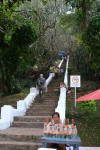 After a further short walk, we came to the foot
of the 328 steps to the top of Mount Phou Si, a 100m-high hill lying
at the heart of the old-town peninsula and home to a Buddhist temple. The plan was to climb
to the top, admire the views, and come down on the other side,
adjacent to the Nam Khan. The steps were organised into sections,
and an entrance fee would be collected part-way up. After the first
section, however, I was dripping with sweat and decided that I was
bowing out at this point. Bruce carried on to the top and I met him again on
the road overlooking the Nam Khan, close to the bamboo bridge. (This
town seemed to have some kind of fascination with dodgy bridges.)
After a further short walk, we came to the foot
of the 328 steps to the top of Mount Phou Si, a 100m-high hill lying
at the heart of the old-town peninsula and home to a Buddhist temple. The plan was to climb
to the top, admire the views, and come down on the other side,
adjacent to the Nam Khan. The steps were organised into sections,
and an entrance fee would be collected part-way up. After the first
section, however, I was dripping with sweat and decided that I was
bowing out at this point. Bruce carried on to the top and I met him again on
the road overlooking the Nam Khan, close to the bamboo bridge. (This
town seemed to have some kind of fascination with dodgy bridges.)
| Oh you'll take the high road ... (Bruce's photos) | |||
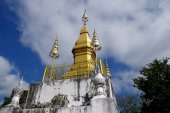 |
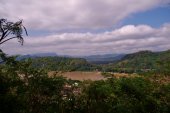 |
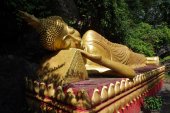 |
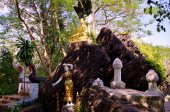 |
| ... and I'll take the low road (my photos) | |||||
 |
 |
 |
 |
 |
 |
 |
 |
 |
 |
 |
 |
The team duly reunited, we walked to the tip of the peninsula, at the confluence of the Khan and Mekong rivers.
 |
 |
 |
 |
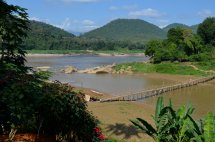 |
 |
 |
 |
 |
| RIGHT: Ah, Pimm's! A civilised pre-lunch drink in lovely surroundings |
 |
 |
 |
We then began following the Mekong riverbank, before long coming to a highly attractive boutique hotel, The Belle Rive. Clearly we needed to have some pre-lunch liquid refreshment in this thoroughly civilised setting!
 Lunchtime! |
 |
 |
 |
It was then merely a short stroll to lunch. We were once again going to be dining out for a cause, as our selected venue was Khaiphaen, a sister restaurant (in the Tree Alliance) of Marum in Siem Reap. As we enjoyed our food and the temporary reprieve from the heat, we both agreed that this was probably the prettiest Asian town that either of us had ever visited. The sheer extent of all the restoration work was probably due, at least in part, to attaining UNESCO World Heritage Site status.
Having spent a good part of the morning walking around the edges of the peninsula, it now seemed like a good idea to concentrate on its spine. This was an area that could be called 'Wat Central', due to the number of Buddhist temples in close proximity to each other. I was a bit careless about keeping note of which temples we chose to visit, but they definitely included Wat Sene and Wat Mai. My main digital SLR camera finally reached capacity during this part of the day, so I realised that I would be relying on my iPhone for the remainder of the trip.
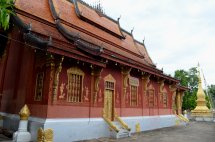 |
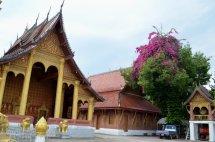 |
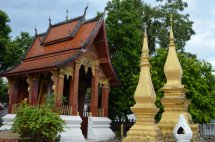 |
|||
 |
 |
 |
 |
 |
 |
| A flavour of the Buddhist temples of Luang Prabang | |||||
Once we had become well and truly 'watted out', we headed back to base for a well deserved rest. Somehow or other, we managed to convince ourselves that actually, the 'Death Bridge' hadn't been all that bad. We decided to use the opposite footpath in the hope that it would be in better condition - no such luck! I noticed a pipeline running under the innermost two rows of planks, and decided to try to stick to these as much as possible. In the event of something happening, perhaps the pipe would save me. It wouldn't be kind to the more sensitive parts of my anatomy as I thumped down onto it, but maybe I'd still be alive. On reaching the other side, we both agreed in no uncertain terms that this horrible structure had now been traversed for the very last time. Before taking a breather in our 'garden bungalow', we called in at the hotel's front desk to book a river cruise for the following day.
When it was time to head out for the evening, we quickly realised that another issue with the hotel's location was that, with its close proximity to a bridge that was closed to general traffic, there were no tuk-tuks to be found in the vicinity. After making one abortive attempt to walk up to a road with normal traffic to see if one would pass by, we decided to make for the bamboo bridge and were somewhat surprised to find it without a map, based on memory alone. Although this bridge had also looked precarious at a distance, in reality it was absolutely sound and we both crossed with confidence.
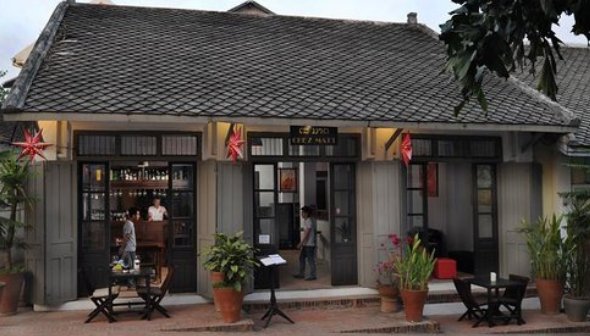
![]() In
fact, the bamboo bridge had delivered us directly to a cluster of
venues, which meant that the considerable amount of walking involved
in our day so far was now at an end. We began with drinks at
Chez Matt, an attractive and welcoming French bar. As we
settled in, rain began to fall. We then moved across the street to
Icon Klub, run by a Hungarian woman who was quite a
character. It was a cosy little place where everyone ended up talking
to each other. The rain was now torrential.
In
fact, the bamboo bridge had delivered us directly to a cluster of
venues, which meant that the considerable amount of walking involved
in our day so far was now at an end. We began with drinks at
Chez Matt, an attractive and welcoming French bar. As we
settled in, rain began to fall. We then moved across the street to
Icon Klub, run by a Hungarian woman who was quite a
character. It was a cosy little place where everyone ended up talking
to each other. The rain was now torrential.
 Finally,
we had a fabulous meal at Tamarind,
gazing out on the relentless deluge from the skies with a kind of
disbelieving fascination. As luck would have it, the section of
street directly outside our restaurant was a recognised waiting zone
for tuk-tuks, and when it was time to head back to base, we managed to persuade one of the drivers to take
us all the way to Le Bel Air via the New Bridge. (He wanted to drop
us on the 'town' side of the Old Bridge. In the dark, in a tropical
downpour, and after a few drinks? Absolutely no way!)
Finally,
we had a fabulous meal at Tamarind,
gazing out on the relentless deluge from the skies with a kind of
disbelieving fascination. As luck would have it, the section of
street directly outside our restaurant was a recognised waiting zone
for tuk-tuks, and when it was time to head back to base, we managed to persuade one of the drivers to take
us all the way to Le Bel Air via the New Bridge. (He wanted to drop
us on the 'town' side of the Old Bridge. In the dark, in a tropical
downpour, and after a few drinks? Absolutely no way!)